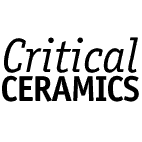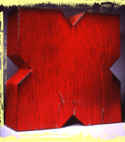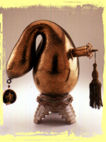



Installation View


Installation View


Installation View
Karen Koblitz
The International Ceramic Highway, a one day symposium, paved its way from the past through the present and on to the future, addressing critical issues for ceramics in the new millennium. Over two hundred gathered on a warm Saturday morning in the Times Mirror Central Court of the Los Angeles County Museum of Art. The symposium was organized in conjunction with the tremendously successful exhibition Color and Fire: Defining Moments in Studio Ceramics, 1950-2000. This survey exhibition displayed 220 works, selected from the museum’s contemporary collection of over 2,500 ceramic pieces.
The symposium opened with welcoming words from Jo Lauria, assistant curator of Decorative Arts at the Los Angeles County Museum of Art and the exhibition’s curator. Lauria describes “ceramics in the second half of the 20th century as being seen as a series of defining moments, points in time when artists came together, and, through their philosophy, research, experiments and art, forever redefined the field.” She then introduced the audience to the day’s moderator, Paul Greenhalgh, President Elect (2001) of the Nova Scotia College of Art and former Head of Research at the Victoria and Albert Museum in London.
In Greenhalgh’s lively keynote address, “Future Modern Genre,” he stated that the issue of the next generation is the problem of “infrastructure.” Artists, collectors, financiers and the general public, are all part of the international infrastructure which must be looked after and tended. He talked about the delicate balance of culture as a whole and its effect on the art world. That culture is constantly in flux, and ceramics is part of this ongoing change.
Greenhalgh sees six big issues relating to the world of ceramics: economy, classification (art/craft/design); ethics (using Bernard Leach’s philosophy as the defining standard); morality; domesticity (how work is displayed and genre of the medium/ whether the Internet will dissolve the gallery); museology (relationship of museums to the general public) and gender (relationship between men and women in clay).
Greenhalgh asks himself, “how do the decorative arts fit into issues of modernity?” He doesn’t want to anguish over the argument as to whether ceramics are art or craft. The principal difference between painting and ceramic objects is price. Greenhalgh doesn’t treat modernism as a style, a rejection of the past. Instead, he sees modernism as an outlook, attitude and recognition of difference. He reminded the audience that with modernity came the invention of museums to save lost cultures, to keep things in a disposable world. “Permanent museum collections legitimize and preserve and dictate the way things go.”
In preserving culture, Greenhalgh felt that museum collecting of contemporary works of living artists is very tricky. He noted that in Great Britain, ceramicists do not have the freedom or range of work as we do in America. It was his opinion, Color and Fire well represented the part played by West Coast artists in the history of American ceramics.
In the new century, Greenhalgh sees the dropping of genre; he predicted that art will be seen as a poetic expression, using any material the maker desires. He illustrated this point with a slide of the work of Tony Cragg, a wall installation of found plastic objects, all in a blue hue, that created the shape of a bottle.
The next speaker was Henry Hopkins, professor of Art at the University of California, Los Angeles and former director of the Armand Hammer Museum. Hopkins also addressed the issue of the artist and genre by speaking about the work at UCLA in which students incorporate clay into their art, forgetting the traditions of clay.
Hopkins began his talk with a slide of a 20,000 BC clay bison. A small image, a spiritual art object of the time, perhaps made to visualize the animal as a three-dimensional object and to capture some capacity of that animal. Ceramics displays the marks of the maker and tools which doesn’t generally happen in other media.
Hopkins spoke of the important influence of California in contemporary ceramics. He was one of many speakers addressing the topic of modernism and the work of Peter Voulkos who led the world of clay into Abstract Expressionism. A misreading of the dimensions of a Japanese raku piece led Voulkos and John Mason to construct a kiln to accommodate their works of over five feet in height. Voulkos’ sculptural works were large in scale, physical and very much about the material and broke the aesthetic sense of perfectness while developing a powerful work. Hopkins acknowledged that in the sixties and seventies, Maurice Tuchman, senior curator at the museum, exhibited the works of Voulkos, Mason and Ken Price, developing a tradition of showing clay as art.
As Hopkins noted, with the work of Ken Price the art public discovered a surreal formalism and a new relationship to the context of the art world. Price’s works have a presence as sculpture which breaks away from the traditions of the vessel. While some pieces are utilitarian, his main body of work is sculptural with non-glazed surfaces which breaks with the purity of traditional ceramics.
In Northern California, the work of Robert Arneson brought political and social concerns with his “funk art” works. Arneson frequently used portraiture, often his own, as a basis for his work. Hopkins showed a video of the controversy surrounding Arneson’s commission of a portrait bust of, George Moscone, the slain Mayor of San Francisco. The ceramic portrait atop a Roman column displayed a narrative of the life of the mayor. It was removed from the Moscone Center by his widow who found many offensive symbols including an impression of the gun used to kill Moscone. Finally, Hopkins spoke of the permanency of the material, allowing ceramics to trace the history of a culture. He said the works of Voulkos, Mason, Price and Arneson will exist in the future while installations of Edward Kienholtz, with many fiber elements, will disappear.
The next speaker was Susan Peterson, artist, professor, lecturer and author of numerous books including a new survey, Contemporary Ceramics. Peterson spoke about “How it was and how it is.” When she arrived in Los Angeles from Alfred University 50 years ago, there were four hundred potteries producing low fire pink flamingos and dinnerware; not one was doing high fire ceramics. In 1952, she built the first high fire kiln west of the Mississippi at Chouinard Art Institute. In 1954, Peter Voulkos arrived and he and his students created the ceramics explosion that as witnessed in Color and Fire. Peterson talked about other west coast influences such as Gertrude and Otto Natzler, Beatrice Wood, Carlton Ball and Marguerite Wildenhain. She entertained the audience with slides from artists worldwide, stressing her view that today’s work has evolved from these ceramic pioneers of the fifties.
The fourth presenter, Dr.Graham McLaren, senior lecturer from Staffordshire University, Stoke-on-Trent, England, spoke of “The Global Influence and Impact of British Studio Ceramics.” He noted diversity as a constant in the history of British Ceramics, focused on a wedding of industrial production and studio pottery. He noted that today’s British ceramicists still look to individuals such as Bernard Leach and Lucie Rie for inspiration, amalgamating and emulating their work through the years. As a recent article declared, Lucie Rie, dominant figure and international emissary, left no important writings. On the other hand, McLaren felt that Leach’s writings far outweigh the importance of his studio work. Indeed, Leach never reconciled his eastern philosophy with the modern world; his work was insulated from connection to the contemporary world. McLaren went on to point out that writings by British artists on ceramics have been very influential. Leach’s philosophy once obscured others but now Michael Cardew’s book of 1959 is very well accepted as is the philosophical and technical writings of Philip Rawson in the seventies.
McLaren promoted the idea that the world influence of the British on studio ceramics came from the immigrant pool, from those who made their mark elsewhere in the world. For example, Charles Binn’s legacy at Alfred University, Michael Cardew in Africa, and Ruth Duckworth in her adoptive city of Chicago. Now emerging from the British contemporary ceramics scene is a deep connection to its past. Dr. McLaren showed slides of Richard Slee, who nods to history with his series of contemporary Toby mugs, and Philip Eglin, whose figurative works look to industrial ceramics in the use of detail on surfaces using the technology of photo silk-screened decals.
The next panelist was Janet Mansfield, maker, writer, and publisher of Ceramics: Art and Perception. As an organizer of events around the world, she talked about the “Global Overview: Shifting Perspectives.” Mansfield noted that influences in her native Australia came from the publication Craft Horizon which, in its time, amazed readers with many new ideas. In the sixties, ceramic artist Margaret Dodd returned to Australia after having studied with Robert Arneson in Davis, California. Her work was called, “Skangaroovian Funk” and deeply changed the face of Australian ceramics. In the seventies, ideas were spread by visiting artists who shared their techniques and aesthetics. This international exchange has led to a borrowing of tools worldwide, such as the use of the anagama kiln from Japan and the French method of paper clay. To Mansfield, this technological exchange frees the maker to find what is closest to their heart, “the fluid mobility of ceramic art.” Mansfield closed by asking the attendees if they thought that the globalization of art was erasing individual trends. Many feel it breaks down the barriers of nationalism. How homogeneous in style will ceramics become?
John Perreault, executive director of Urban Glass, art critic, and editor of Glass Magazine, brought an exciting conclusion to the day’s speakers. He became interested in the 20th Century craft movement through feminist art when he wrote about the collaboration of works between painter Joyce Kozloff and ceramicist Betty Woodman. Perreault began his presentation by saying “It’s definitely global, but is it art?” and two aphorisms “To tamper with categories is to tamper with power” and “Borders don’t exist until you try to cross them.”
Perreault’s dynamic delivery brought focus to the question “Is it art or craft”, as he went presented a series of works by Marek Cecula, Beatrice Wood, Jeff Koons, Robert Arneson, Peter Voulkos and Adelaide Robineau. Perreault felt that not so long ago, it was easy to make the distinction between utilitarian object and sculpture; today it is more difficult to distinguish the two. He wondered why we separate art from utility. Is it a class distinction? Is craft better than sculpture because more people understand it? The western world would be turned upside down if ceramics was higher than painting, as it is in Asia. Perrault still calls the non-functional vessel a vessel and he sees nothing wrong with calling something a vessel and yet elevating the form.
Perreault noted that the five traditional craft materials (clay, glass, wood, fiber and metal) must be accepted as art since materials as lard and excrement have been accepted. To Perreault, art is the larger category in which sculpture, painting, photo, and ceramics are a part. Apples, oranges and lemons are all distinct but all are fruit. He asks “is it simply that there is not enough room at the table” that craft isn’t widely included in the art world? Perreault stated that anything made as art, intended as art, bought and sold as art, perceived as art, is art. Hierarchy is essential to craft/art discussion. Hierarchies are eternal, not historical, they are self-imposed. He feels that the craft that is now practiced can now unabashedly be called art.
A question and answer period followed the presentations. An audience member quizzed the panel about their feelings in reference to a recent article in the Los Angeles Times that criticized the Color and Fire exhibition for not including more artists of Generation X, those artists born after 1963. Perreault responded by stating that most new artists are global, many from other countries where support is lacking for the next generation.
Paul Greenhalgh added that art is generational. Our parents didn’t understand our music, dress, language or art and the same holds true for the next generation. Janet Mansfield responded that to find the next generation of artists, one must look to teachers and art schools. Tony Marsh, professor at Cal State Long Beach added that the infrastructure makes it harder for talent to come out of the system and find it’s way. Hopkins added that there is a tremendous amount of new talent today and the boundaries of materials have disappeared.
Frank Lloyd, a Santa Monica gallery owner, asked the panel if the craft movement is dead, what form will these ceramic exhibitions take place in the future? Henry Hopkins said he would love to see an exhibition of the true history of ceramics, including tile artists, that explores the media in California.
An audience member asked if museums have a collecting policy. Henry Hopkins replied, unless ceramics is included in the role of sculpture, it is generally not included in a collections directive. He then cited the Everson Museum’s extensive ceramics collection. Jo Lauria pointed out the loss of resources ended the continuum in this collection in the 1970’s. Lauria said that Maurice Tuchman, whose vision in the 60’s gave shows to Voulkos, Mason and Price, laid the groundwork for courting certain collections. Her job as curator at LACMA has been made easier by this past history. She hopes that LACMA will continue to acquire contemporary objects by active makers. Paul Greenhalgh added that at the Victoria and Albert Museum in London, there isn’t a problem in fighting to add ceramics to the collection, the problem is financial. The V and A has the only collection of American ceramics in Britain because the cost of acquisition is prohibitive.
The day’s activities ended with the screening of the film “Color and Fire.” The fifty minute video is a compilation of interviews of ceramicists in their studios, talking about their lives and work. It features discussions concerning Abstract Expressionism, Funk, sculpture, the vessel and the role of ceramics in world art by many of the leading figures in the field of ceramics.
As the Ceramic Highway cruised to an end, it could be said that the ride was quite invigorating. Meetings of this nature, offering a dialogue with prominent figures in the field, are essential to the place of ceramics in the world of art. One hopes that in the future, more and more travelers will get on the highway and enjoy the scenery.
The “Color and Fire” catalog and video are available through the Los Angeles County Museum of Art bookstore.The phone number is (323) 857-6146. The catalog is also available at http://www.amazon.com.

“Red X”
John Mason
1966


“Cacaesthesia”
Adrian Saxe
1992


“Double Bottle”
Beatrice Wood
1970